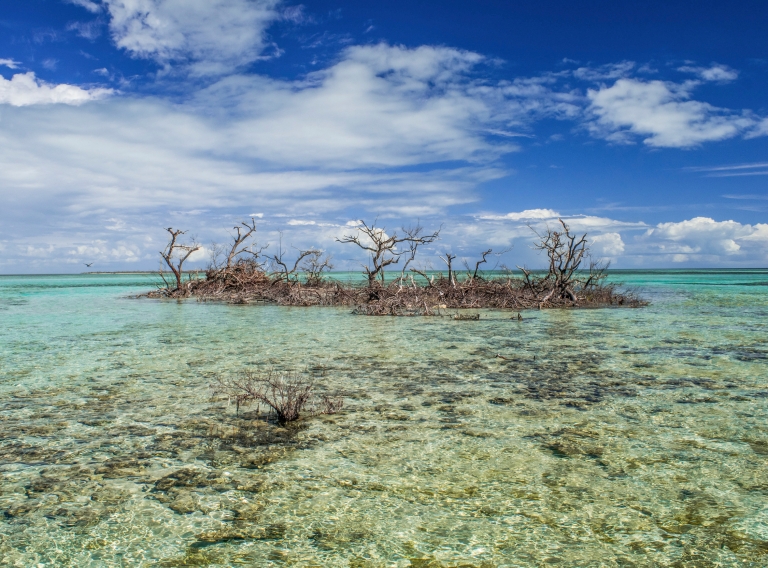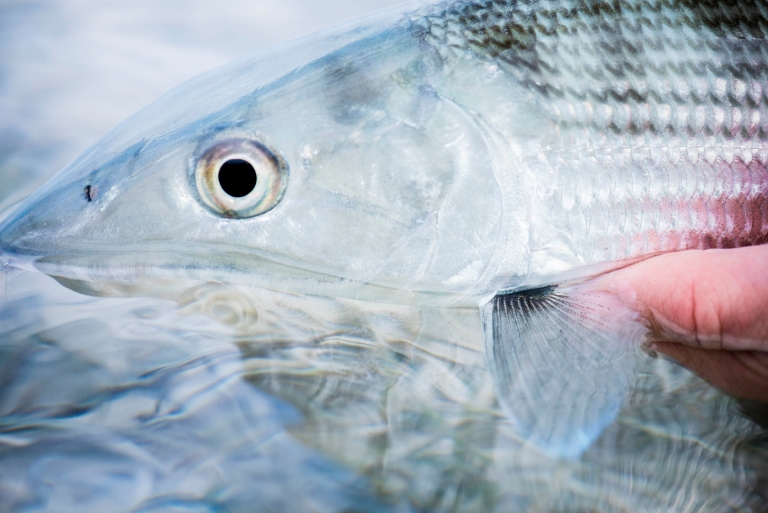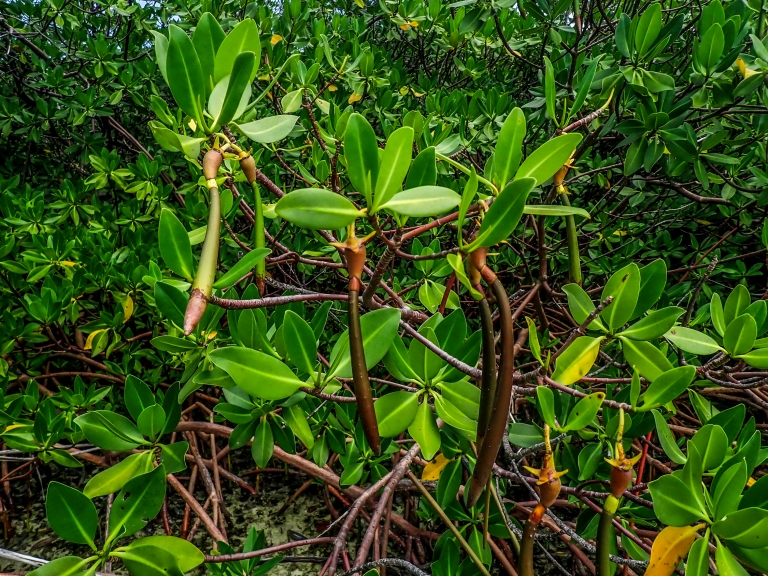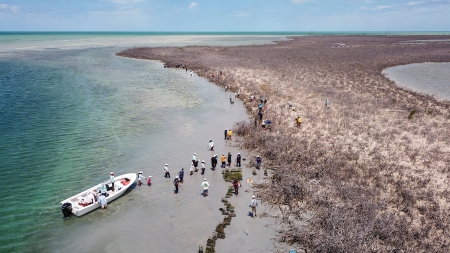It’s All Home Water: The Bahamas
Roots and recovery on Abaco and Grand Bahama Islands.
Every few days between April and November, a low-pressure disturbance called a tropical wave moves from the west coast of Africa to the Atlantic Ocean, where the trade winds carry it westward. Most dissipate in a matter of days or weeks, but when atmospheric conditions align, a tropical wave can spawn a hurricane. On August 24, 2019, a large wave that left Africa five days earlier formed a tropical storm in the middle of the Atlantic, about 800 miles from Barbados. The National Hurricane Center named it Dorian.
At first, Dorian didn’t seem to pose much of a threat. The storm sputtered, stifled by dry air from a Saharan dust storm that blew over the Atlantic. But Dorian gained traction as it spun into the Caribbean, where the unpredictable storm kept forecasters guessing. After strengthening to a hurricane on August 28 as it passed over the US Virgin Islands, Dorian defied forecasts by slipping east of Puerto Rico and rapidly intensifying, fueled by moisture-rich air and abnormally warm water, effects of climate change. Dorian reached Category 3 strength in only three days before unexpectedly becoming a Category 5 monster on Sunday, September 1, as it bore down on the northern Bahamas.
At 12:40 p.m., Dorian made landfall at Elbow Cay, Great Abaco, with winds of 184 mph, making it the strongest storm on record to strike the Bahamas. Dorian made a second landfall about an hour later near Marsh Harbour where Justin Sands, a bonefish guide for more than 20 years, sheltered in his home as the ocean pushed inland and 220 mph gusts lashed the island. Next door, the rush of seawater forced Sands’s sister, brother-in-law and nephew out of their house, situated downhill from his. As the eye of Dorian approached, Sands braved the deluge in hopes of helping them reach higher ground.

In 2019, Hurricane Dorian damaged or destroyed nearly 74 percent of Grand Bahama’s mangroves and 40 percent of Abaco’s mangroves across a combined area of 69 square miles. Photo: Justin Lewis
“There were five different vehicles parked in my backyard, and I swam over the top of all of them and didn’t touch one of them,” said Sands, recalling the incredible storm surge. He joined his family on the lee side of their house, where together they endured the brunt of Dorian, waiting for its eye to bring calmer winds. “Time is one of those funny things when you’re in a storm like that,” Sands said. “Time didn’t mean anything.”
When the eye finally arrived, Sands estimated that the winds subsided to 80 to 90 mph, and the waters began to recede, allowing him and his family to make it back up to his house. Relatives whose houses had collapsed soon joined them. By the time the eye passed, there were 13 family members sheltering with Sands in his home. Then the second half of the hurricane arrived.
“It was unreal,” he said. “I hope I never live to see another one like that.”
The superstorm leveled Abaco Lodge before lumbering west. On September 2, Dorian engulfed the east end of Grand Bahama Island, hallowed ground among bonefish anglers. After demolishing the historic Deep Water Cay lodge and East End Lodge, Dorian crawled across the island and then stalled, unleashing a three-day nightmare for those sheltering in place. Among them was Livingston Tate, who has guided for Deep Water Cay and North Riding Point Club during his 35-year career. Tate and his family weathered the storm in Freeport, where the relentless winds tore pieces of their house away and ripped holes in the roof. Epic flooding claimed his skiff and the salt water ruined his boat motors.
“We continued to pray because everything was blowing up and blowing off,” said Tate. “It was frightening, but we stayed calm and rode it out together.”
The worst natural disaster in the nation’s history, Hurricane Dorian claimed the lives of 74 people and at least 200 remain missing. Dorian left a humanitarian crisis and displaced thousands of Bahamian citizens. The storm damaged critical infrastructure on Abaco and Grand Bahama, flooding their airports and knocking out the islands’ power and telecommunications. It impacted every bonefish lodge, forcing their operations to a halt only weeks before the prime fall season.

Quick as a flash, a Long Island (Bahamas, not New York) bonefish gets the paparazzi treatment. Photo: Jeremiah Watt
As the floodwaters receded, the catastrophic damage to the environment became apparent. Justin Lewis, Bonefish & Tarpon Trust’s (BTT) Bahamas initiative manager, has lived through his share of hurricanes, but nothing could have prepared him for what he encountered when he ventured out to the east end only days after Dorian pummeled it. “Sometimes after storms there will be patches of dead mangroves here and there,” said Lewis, who was raised in Freeport. “But the vastness of the destruction caused by Dorian was beyond compare.”
Red mangroves thrive along the harsh border between the land and the sea and are an essential component of a healthy flats habitat. These resilient, shrub-like trees are evergreen and produce yellow flowers. They’re sometimes called “walking trees” because their exposed, reddish roots make them look as if they’re walking on water. Their roots literally hold the flats together, preventing erosion. Mangroves also provide foraging grounds for bonefish, which follow the high tide deep into them to feed on crabs and shrimp. And the sandy bottom found in some areas protected by mangrove-fringed edges is important habitat for juvenile bonefish. In these ways, mangroves sustain the Bahamas’ flats fishery, which generates $169 million annually for the national economy. But Dorian’s punishing winds and powerful storm surge reduced vast expanses of verdant mangrove forests on Abaco and Grand Bahama to leafless brown wastelands stretching to the horizon. Some of the mangroves that died had stood for more than 100 years.
For Tate, who needs healthy flats and abundant bonefish to earn a living, the sight was hard to bear. “My heart was broken, and I started to cry,” he said. “Because I’d never seen nothing like that in my life.”
Not just bonefish depend on mangrove forests. These forests are among the most productive and biodiverse ecosystems on the planet, and in the Bahamas, they serve as nurseries for commercially important spiny lobster and many species of fish, including tarpon, snook and snapper. Mangroves are also essential habitat for a variety of birds and a refuge during seasonal migrations.

Studies demonstrate that mangroves sequester carbon at a rate two to four times greater than mature tropical forests. These irreplaceable plants also filter pollutants, stabilize shorelines, protect against storm surges and provide wildlife habitat. Photo: Justin Lewis
Mangroves help protect people, too. They prevent coastal erosion and shield communities against storms by blunting the force of wind and waves. They also slow the flow of water, reducing storm surge flooding. Without mangroves, Dorian would have been even more destructive.
On a global level, mangrove forests are more important than ever. They store enormous amounts of carbon—more per acre than any other type of forest—thereby mitigating climate change. Most of the carbon is locked away in their peat, where it can remain for millennia. When mangrove forests are destroyed, the carbon is released back into the atmosphere or ocean as the greenhouse gas carbon dioxide.
To determine the extent of the damage to the northern Bahamas’ mangroves, BTT turned to collaborating scientist Michael K. Steinberg, a professor of geography at the University of Alabama who specializes in tropical conservation issues. Also an avid fly-angler, Steinberg has worked extensively in the Caribbean, mapping sport-fish habitat and threats in Belize and mangrove-forest-cover changes in Mexico, Cuba and the Bahamas. Even he was shocked by the scale of the devastation on Abaco and Grand Bahama.
“It was cataclysmic,” he said. “I’ve seen hurricane damage. I’ve seen mangroves cut for resort development, but I’ve never seen such extensive mangroves stripped of all their leaves and just rotting.”
Steinberg mapped the destruction by surveying affected areas and comparing high-resolution satellite imagery from before and after the storm. His final report is sobering. Dorian damaged or destroyed nearly 74 percent of Grand Bahama’s mangroves and 40 percent of Abaco’s mangroves across a combined area of 69 square miles. All of the damage on Abaco occurred in the northern portion of the island and the Marls, a national park that offers some of the most productive bonefishing in the world.
“Even though mangroves were heavily impacted, underwater habitats, like seagrass beds, are still intact,” Lewis said. “And the bonefish and permit populations that live around the impacted flats are still healthy, and the fishing has been good. But in order to ensure the sustainability of the fishery and the health of the flats into the future, mangrove restoration is essential.”

Kyle Rossin and Justin Lewis plant seedlings amid decaying mangroves destroyed by Hurricane Dorian. Photo: Nick Roberts
The damage that hurricanes inflict on mangrove forests is usually patchy, allowing them to recover on their own. Currents carry the propagules (mangrove seeds) from the surviving trees to the damaged areas, where they take root and grow. These propagule-producing trees are known as a seed bank. But Dorian was not your average hurricane, and the destruction it caused on Grand Bahama and northern Abaco was so extensive that no seed bank remains in the hardest hit areas.
“Without human intervention, the islands’ mangrove forests would take well over a decade to regenerate, and at the most severely damaged sites, recovery may not occur at all,” said Lewis.
To jumpstart the natural recovery process, BTT and their partners Bahamas National Trust (BNT), Friends of the Environment (FRIENDS) and MANG, a Florida-based apparel brand that plants a mangrove for every product sold, have launched the Northern Bahamas Mangrove Restoration Project, the most ambitious mangrove restoration in Bahamas history. Over the next five years, the binational coalition will transplant 100,000 seedlings on Abaco and Grand Bahama with the assistance of Bahamian students and fishing guides whose work has been curtailed by hurricane damage and the COVID-19 pandemic, including Sands and Tate.
“Our organizations working together helps ensure a better chance of success for these important restoration efforts,” said Eric Carey, BNT’s executive director. “The plans to involve the local communities that depend on healthy mangroves and their associated habitats and ecosystem functions are also important to this program. This will help ensure the buy-in needed for the long-term impact of our collective efforts.”
The seedlings will be planted in areas identified by Steinberg’s surveys as those most in need of restoration. “Over the next few years, they’ll grow into trees capable of producing propagules to support natural recovery,” said Lewis, the project lead. “The seedlings will also help keep the flats from eroding as the dead mangroves decay.”
In the age of climate change, erosion is especially problematic. It not only diminishes the available habitat for bonefish and other species that depend on healthy flats but also makes coastal communities more vulnerable to the effects of sea-level rise and damage from increasingly powerful hurricanes. And if the peat layer beneath the dead mangroves erodes, the carbon it holds will be released. Losing the peat would also impede the successful transplantation of mangrove seedlings on damaged flats, adding urgency to the restoration project.
“You really need that stable peat base to protect those seedlings,” Steinberg explained. “Without that nutrient-rich, stable base, seedlings will potentially wash away the first time a big storm blows through.”
Producing the seedlings necessary for such an extensive restoration project is no small feat. Research shows that transplanted seedlings have a much higher survival rate than propagules, so this step is essential. Last fall, MANG launched a grassroots Florida-wide collection campaign, gathering more than 70,000 propagules. Thousands of the resulting seedlings were shipped to the Bahamas, where propagule-collection efforts are also underway.

A recent aerial shot of Grand Bahama shows the devastation to the mangrove forests brought on by Hurricane Dorian. Photo: Austin Trigg
The project also depends on the expertise of local bonefish guides, who are eager to help restore the habitats that support their livelihoods and protect their communities in the face of more intense storms. “Mangroves play such an important role, man,” said Tate, whose father taught him to fish around Grand Bahama. “It’s really something great that we’re doing.”
The guides’ intimate knowledge of the affected areas, passed down through generations and gained from years spent poling their skiffs across long-familiar flats, is vital to the success of the restoration. The guides help select planting sites within the highest impact areas and then ferry coalition members and mangrove seedlings to those spots, navigating the vast coastlines and serpentine tidal creeks they know by heart.
“Without the mangroves, you don’t have much for life to grow back,” said Sands, an eighth-generation Abaconian. “The mangroves are the nursery that everything grows from, especially in the Marls where we fish.”
The extra work provided by the project will help the guides get back on their feet as the slow recovery from Hurricane Dorian continues, a process hampered by the global pandemic. Nearly every guide Sands knows was affected by the storm and his own business is down 90 percent. “I don’t think I’ve guided more than 15 days since Dorian—maybe 20,” he said, adding, “I think if we would have not had the pandemic, my business would have been back up to 60 percent.” During the lull in guiding, Sands has relied more heavily on his seasonal work as a commercial lobster fisherman.
The mangrove habitats the guides are working to restore are the foundation for the northern Bahamas’ lucrative flats fishery, which has attracted anglers since the 1950s. But the fishery doesn’t just support guides, lodge owners and staff; it generates critical revenue for Abaco and Grand Bahama’s airports, hotels, restaurants and bars, all of which employ people from the local communities. And so the restoration project will have a far-reaching impact, both benefitting the recreational fishing industry and underpinning the larger economic recovery taking place.
In the project’s first phase, completed earlier this year, the coalition transplanted 4,608 seedlings at Grand Bahama’s east end and north shore and 1,440 in the Marls of Abaco, spread among five locations Sands selected. BTT is working with Craig Layman of Wake Forest University to monitor test sites, where he’ll gauge the effectiveness of the transplanting by measuring the growth, survival rates and health of the young mangroves at regular intervals. The results will help the coalition fine-tune its planting strategies as the restoration progresses.
Locals in the northern Bahamas are also active in the project. Coalition partners BNT and FRIENDS, a nonprofit conservation organization in Abaco, are leading the project’s education program wherein students learn about mangrove ecosystems by growing seedlings at nurseries and taking field trips to plant and monitor them. At the first community-wide event in East Grand Bahama in May 2021, students, bonefish guides, government officials and volunteers joined forces to plant 4,113 mangrove seedlings at the north mouth of Roemer Creek, bringing the project’s total number of planted mangroves to more than 10,000.
“By reaching out to the community and working together to restore these ecosystems, we are helping to reinforce the understanding that local communities play an integral role in environmental sustainability, which then supports our economy and livelihoods,” said Olivia Patterson-Maura, deputy director of FRIENDS. “Building up the health of our ecosystems and communities is a key part of our recovery from Hurricane Dorian and our resilience against future climate disaster.”
Poet William Carlos Williams famously wrote, “so much depends / upon / a red wheel / barrow … ” The same is true of the red mangrove. Mangrove forests are a cornerstone of the Bahamas, supporting the multimillion-dollar flats fishery, the nation’s coastal communities and the biodiversity the islands boast. As the planet warms and mangrove deforestation continues worldwide, protecting and restoring red mangroves will become even more important to the health of the larger flats fishery—from Grand Bahama to the Florida Keys to Ambergris Caye in Belize—and the many coastal communities that it sustains.
Restoration is fundamentally an act of hope: the hope to reclaim what was lost, the hope to make whole again what is broken, the hope to mend what was ravaged by time or circumstance. To plant a fragile, foot-tall mangrove seedling on the edge of a battered, lifeless flat requires this pure sort of hope—the hope for a new beginning for a fishery and for people like Sands and Tate, who have lived their lives to the rhythm of the tides that compel bonefish across the flats and into the mangroves, brimming with life and connecting the land to the sea.
“It’s going to take a while,” said Sands, “but we’ve got to start with one step.”
With any luck, the transplanted seedlings growing now on the scarred flats of Abaco and Grand Bahama will mature into trees that outlive us all. In this sense, the project is generational in scope, benefitting people not yet born. The work being done will also help secure an environmentally sound future for the students who are lending a hand. Some may grow up to be bonefish guides or scientists, following in the footsteps of Sands or Lewis, and spend their days exploring healthy green flats and coastlines that they’ll be able to say they helped to heal, many years ago.
Help Restore Flats Habitat
Restoring the Northern Bahamas’ mangrove forests destroyed by Hurricane Dorian is critically important to the health of the region’s flats fishery. Support this vital work by donating to Bonefish & Tarpon Trust’s Northern Bahamas Restoration Project.



